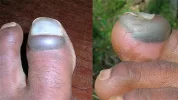Welcome to the forum, Lucy

Feet swell width-wise during a day of hiking, not lengthwise. However, one's normal length of street shoe size does not take into account the added weight of a pack compressing feet making them a bit longer, or wearing thicker socks which require more length, or having a thicker third party insole which also requires more length, and the needed space to keep one's toes from banging against the front of the shoe on downhill stretches, which will cause blackened and lost toenails, pain, and skin abrasions.
Blister are caused by the friction of shear forces on the skin. What has been found over the years, is that the old advice to have 'tight' fitting or 'snug' footwear in order to avoid blisters, will often be the cause of shear forces taking place between the foot and the sock, which
will cause blistering. A slightly looser shoe allows the shear force to stay between the sock and the shoe. This is not 'sloppy' loose, just a 'comfortable' type of loose. When heading on a longer downhill grade, the main concern is your toes banging the shoe, so I will stop and tighten up my laces after I have snugged my heel to the back of the shoe. When I reach the bottom, I will go ahead and loosen the laces back to normal.
The sock should be slightly snug, not tight, to keep from rucking and moving around on the foot. A skin lubricant, like Hiker's Goo or Body Glide, applied to the feet will also be of some help for even slight movement of the sock against the skin. Pre-taping blister prone areas, and recognizing what a 'hot spot' is when it develops, and then immediately dealing with it as you're walking are also blister reduction strategies.
When getting hiking or walking footwear fitted, it doesn't matter what the measured size of your foot is --- that is just a guideline. What matters is how it feels.
There are two major foot measurements to focus on.. length and width. When I try on footwear, I have my pack loaded with about 25 pounds of weight (which is far higher than needed pack weight on Camino). I wear the same socks I normally would wear, which in my case a Smartwool lightly padded PH.ds. I bring the same insole that I will be wearing. When measuring my foot, I am wearing my pack and socks, standing up, centered on the measuring device, with my weight shifted to the foot being measured (crudely mimics the force on that foot when it strikes the ground while walking).
My feet are anywhere from 2ee wide to 4ee wide -- depending on who manufacturers the footwear. The length measurement can be between 9.5 and 11, again depending on manufacturer. There is no set 'standard' agreement as to measurement in more than a broad sense. That is because every footwear manufacturer has its own set of foot models, or lasts that it uses to make its shoes. That is why some footwear makers have 'wider' toeboxes than others. Or why a double wide width in one manufacturers shoe line ,feels tight in anothers.
That is why one buys by 'feel' and not measurement. If the measurement feels good, that's fine; but if it doesn't, move on. That same rule also applies to the model of shoe itself.
It matters not one bit if a model of shoe is favored and adored by ten thousand people, what matters is how it feels and performs for YOU. I cannot tell you the number of times, as a backpacking gear tester, that a manufacturers shoe felt 'off' or uncomfortable on my feet, even when they fit perfectly; and yet it had received rave reviews by tons of people. And when I submitted my report detailing why I felt they were not comfortable, I had the quality control director point to how many liked them as the rebuttal of why my findings were invalid. Funny thing, though, If my report also detailed how well made I found the shoes, and how durable they were and any other positive findings, that was accepted at face value.
When you actually are trying on the shoes, if you are going to be using a third party insole, take out the insole that comes with the shoe and put yours in. Walk around with your pack on. With your shoes tied as for a steep downhill grade, try to see if you can jam your toes to the front of the shoe. If you can feel your toes touching, move up a half to a full size. The best way of testing this is on a sloping incline facing 'downhill', and then exerting your foot forward in an exaggerated force inside the shoe, as you keep the shoe itself firmly in place on the incline.
Pay attention to where any pressure from the shoe exerts itself on the back of the foot and achilles tendon area. In some shoes, the heel cup is exaggerated enough that some feet will have the collar of the shoe rubbing or pressing on that upper heel and tendon area. If not modified, that will cause severe blistering or tendonitis or both.
The information on blister treatment is found on the forum, and you can use the search engine provided to find those threads. There is also a lot of footwear information that can be found, also by using the search engine.






















